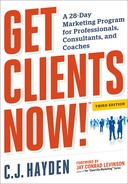Ingredient: Brochure
The first thing you should consider about creating a brochure is whether you need one at all. Many successful consultants, professionals, and coaches never develop a brochure. When they communicate in writing, they rely instead on personal letters and a few supplemental items, such as a professional biography or résumé and a client list. The rest of the time they refer prospective clients to their website instead of using print materials. When you are just starting out, paying for the design and printing of a brochure can be an expensive mistake if the nature of your services, or profile of your target market, is still in flux.
Look at what your successful competitors are doing. If they all seem to have brochures, you may need one also. If they don’t, or there seem to be mixed opinions on this subject in your field, ask yourself whether having a brochure will make a positive difference with your prospective clients. If you think it will, how much brochure can you afford?
The simplest and most inexpensive brochure is a standard tri-fold that you or a graphic designer lays out, and prints or photocopies on standard paper stock or preprinted paper designed just for brochures. For marketing personal or household services to consumers, this may be all you need. For business-to-business marketing, a professionally designed and commercially printed brochure will be much more effective. As a general rule, the more expensive your service is, the more expensive your marketing materials should be. Hire a graphic designer, copywriter, or marketing communications specialist to help you, and be sure to work out a budget in advance.
The best way to decide what will go into your brochure is to review many examples of what others have included. Here are some of the typical elements of a tri-fold brochure:
![]() Attention-getting cover design, perhaps with a logo or photo
Attention-getting cover design, perhaps with a logo or photo
![]() Tag line, positioning statement, or competitive advantage
Tag line, positioning statement, or competitive advantage
![]() Description of the services you offer
Description of the services you offer
![]() Details about your target market or professional specialty (e.g., “We work with health care companies” or “My specialty is intellectual property law”)
Details about your target market or professional specialty (e.g., “We work with health care companies” or “My specialty is intellectual property law”)
![]() Benefits and results of working with you
Benefits and results of working with you
![]() Brief biography of you, your company, or both
Brief biography of you, your company, or both
![]() Client list, testimonials, or endorsement quotes
Client list, testimonials, or endorsement quotes
![]() Photographs or illustrations of you or your work
Photographs or illustrations of you or your work
![]() Address, phone, e-mail, website, and social media profiles
Address, phone, e-mail, website, and social media profiles
Remember that your brochure should be designed primarily for use in follow-up rather than for filling the pipeline. If you are sending it by mail, it will typically be accompanied by a personal letter or note, and in most other situations, you will be giving your brochure to someone you have had some contact with already. So don’t feel your brochure has to communicate everything there is to know about your business. A brochure’s best use is to support your marketing activities rather than replacing them.
